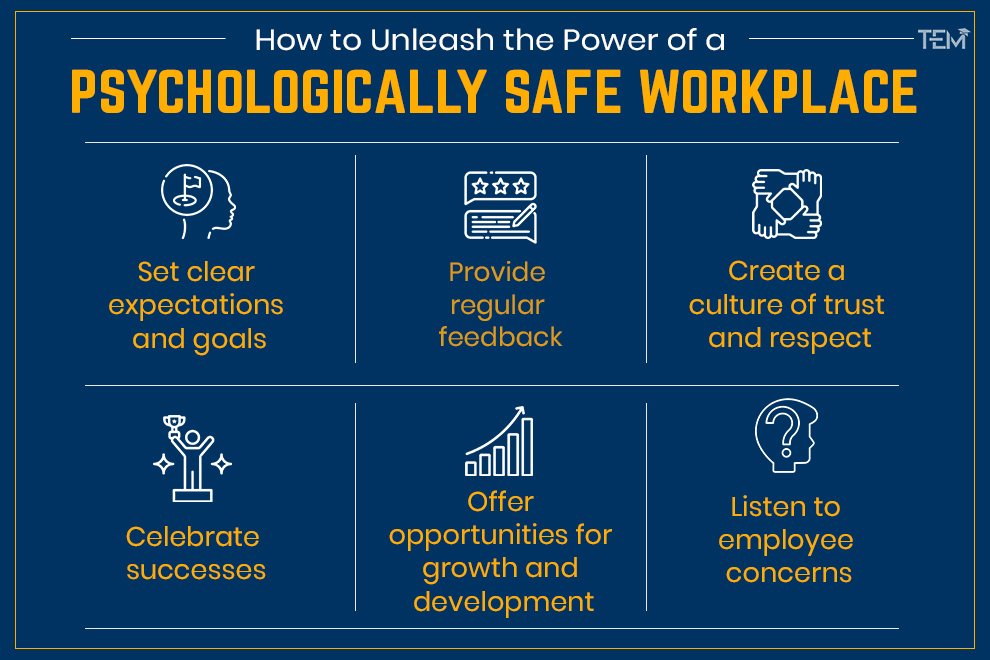A psychologically safe workplace is a term that has gained significant attention in recent years due to its crucial role in fostering employee well-being, productivity, and overall organizational success. It refers to a work environment where individuals feel comfortable and secure enough to express their thoughts, ideas, and concerns without fear of judgment, reprisal, or negative consequences. Such a workplace cultivates a culture of trust, respect, and open communication, allowing employees to bring their authentic selves to work and collaborate effectively. Its significance in today’s professional landscape and the benefits it can bring to employees and organizations.
What is a Psychologically Safe Workplace?
It is the belief that individuals won’t be punished or humiliated for speaking up with ideas, questions, concerns, or mistakes. It fosters an environment where people can brainstorm, voice half-finished thoughts, challenge the status quo, and work through disagreements. When present in the workplace, psychological safety allows individuals to bring their authentic selves, leading to better collaboration and innovation.
As per the study, nearly 300 leaders over 2.5 years revealed that teams with high psychological safety reported higher performance levels and lower interpersonal conflicts. Particularly for senior leadership teams, there were significant differences in perceived levels of psychological safety, with 62% of teams demonstrating variability. This variability hinders the expression of innovative ideas, limits problem-solving, and prevents teams from reaching their full potential.
Why is it important?
A psychologically safe workplace is essential for efficient and effective business operations. Without it, employees won’t trust their employer, negatively impacting the entire organization. Encouraging open communication and psychological safety includes valuing work-life balance that makes employees feel secure. Encouraging authenticity and prioritizing the organization’s well-being can lead to long-term success as employees become more invested in its success.
- According to a survey conducted in 2018 by the Harvard Business Review, organizations characterized by elevated levels of psychological safety exhibited a 1.7-fold increase in employee engagement and a 1.4-fold increase in employee productivity compared to organizations with low levels of psychological safety.
- In 2019, the University of Pennsylvania conducted a study that discovered employees who experienced psychological safety were 50% more likely to report feeling happy in their work environment. Furthermore, they were 45% less likely to report burnout.
- Findings from a survey conducted by the World Economic Forum in 2020 indicated that organizations with high levels of psychological safety were 2.5 times more likely to report the achievement of their business objectives.
- Furthermore, a study conducted in 2021 by the University of California, Berkeley, revealed that employees who felt psychologically safe were 57% more inclined to remain with their organization for at least three years.
6 Signs Your Workplace Is Psychologically Unsafe
If you are uncertain whether your workplace is providing a psychologically safe environment, there are some warning signs you should be aware of:
1. People don’t feel comfortable taking risks or making mistakes.
- A study by Google found that teams with a high level of psychological safety were 1.5 times more likely to be innovative.
- Another study by the University of Pennsylvania found that employees who felt safe taking risks were likelier to be engaged in their work and reported higher job satisfaction.
2. Employees refrain from speaking up or sharing ideas.
- A survey by Workplace Options found that 65% of employees are afraid to speak up at work.
- Another survey by the Society for Human Resource Management found that 40% of employees have left a job because of a lack of communication.
3. There’s a lot of gossip and backstabbing.
- A study by the University of California, Berkeley found that gossip can lead to decreased productivity, increased stress, and even health problems.
- Another study by the University of Michigan found that employees exposed to gossip are more likely to experience anxiety and depression.
4. There’s a lot of turnovers.
- A Society for Human Resource Management study found that the average cost of replacing an employee is 1.5 times their annual salary.
- Another study by the Aberdeen Group found that companies with high turnover rates are 2.5 times more likely to experience financial losses.
5. Employees are stressed and anxious.
- A study by the American Psychological Association found that 70% of employees report feeling stressed at work.
- Another National Institute for Occupational Safety and Health study found that work-related stress can lead to various health problems, including heart disease, high blood pressure, and depression.
6. Employees are less productive.
- A study by the University of Warwick found that happy employees are 12% more productive than unhappy employees.
- Another study by the University of California, Berkeley found that employees who feel supported at work are more likely to be engaged in their work and to be productive.
How to Create a Psychologically Safe Workplace?
If you suspect that your organization may not meet the criteria for being a psychologically safe workplace for your employees, and you are interested in enhancing this aspect but uncertain about the necessary steps or initiatives to undertake, the following recommendations present six effective strategies for fostering psychological safety within your organization’s working environment:
- Set clear expectations and goals: When employees know their expectations, they are more likely to feel confident and safe taking risks. According to a study by the Harvard Business Review, teams with clear goals are 2.5 times more likely to achieve their objectives.
- Provide regular feedback: Providing employees with constructive and supportive feedback can help them learn and develop while fostering a sense of psychological safety in the workplace. A study by Gallup found that employees who receive regular feedback are 30% more likely to be engaged in their work.
- Create a culture of trust and respect: A culture of trust and respect is essential for psychological safety. When employees trust their colleagues and managers, they are more comfortable taking risks and sharing their ideas. A Society for Human Resource Management study found that employees who work in a trusting environment are 70% more likely to be engaged.
- Celebrate successes: Celebrating the achievements of employees promotes a feeling of accomplishment and belonging. Boosting morale and making employees feel valued can have a positive impact. A study by the University of Warwick found that employees who work in a positive and supportive environment are 12% more productive.
- Offer opportunities for growth and development: Employees are more likely to feel engaged and motivated when they feel like they are constantly learning and growing. A study by the World Economic Forum found that 94% of employers believe that upskilling and reskilling their employees is essential for future success.
- Listen to employee concerns: When employees feel heard and addressed, they are more likely to feel valued and respected. A study by the American Psychological Association found that employees who feel that their concerns are heard and addressed are 3.5 times more likely to be engaged in their work.
How is it Beneficial?
Not only does psychological safety improve your team’s performance, but it also enhances employee engagement. When team members feel that their insights are appreciated they:
- They feel like a respected part of their team.
- See the value of their work.
- Feel accepted for who they are and the unique strengths they bring.
Once employees feel secure within the work environment you provide as a leader, they will align themselves with your mission and become fully committed members of your organization. Improving the quality of services offered to clients will elevate your business and establish it as a successful venture with a notable market presence. This is a significant step towards success. The degree to which employees feel secure is directly proportional to the growth and stability of your business.
Conclusion
In conclusion, a psychologically safe workplace promotes trust, open communication, and inclusivity, increasing productivity and overall organizational success. By prioritizing employees’ emotional well-being, organizations create an environment where individuals can freely express themselves and contribute without fear of judgment or reprisal. Psychological safety empowers employees and fosters a positive work culture that attracts and retains top talent.
FAQ’s
- How can I deal with a psychologically unfit workplace?
It is important to remember that you are not alone. Many people have experienced a psychologically unsafe workplace. If you are in this situation, resources are available to help you. You can talk to a therapist, a lawyer, or a labor union. Many websites and organizations offer support to people who are dealing with psychologically unsafe workplaces.
- What are the challenges of creating a psychologically safe workplace?
There are several challenges to creating a psychologically safe workplace. Some of the most common challenges include:
- Lack of trust and respect.
- A culture of silence.
- A focus on blame and punishment.
- A need for diversity and inclusion.
- A toxic work culture.
- What is one of the largest benefits of a psychologically healthy workplace?
One of the largest benefits of a psychologically healthy workplace is increased employee well-being. When employees feel safe, supported, and respected at work, they are likelier to report feeling happy, healthy, and fulfilled. This can lead to a decrease in stress, absenteeism, and healthcare costs.
ALSO READ: 10 Activities to frame your Self-esteem and think positive about yourself










